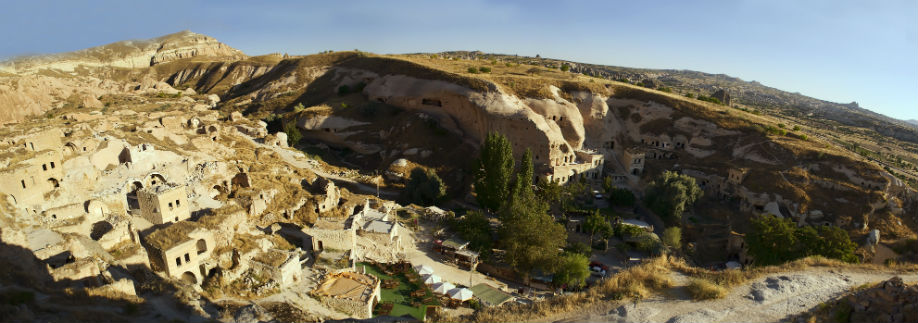Cavusin Village is 4 km away from Goreme–Avanos road in Cappadocia. Basically houses surround a mountain like massive rock. It is all messed up as a result of the erosion of the rocks over time and earthquakes.
There are relatively new stone buildings in the front of old stone blocks. You can see domed structures that get higher towards the top of the rock as well as praying buildings, monks cave and shelters among the houses. They look like an ant colony looking from above. Saint Baptist Monastery, which is one of the oldest building in Cappadocia, is hidden among the rocks here.
It is an enormous basilica carved in the top part of the rock. Nicephoros Phocas church is beside Goreme-Avanos road, 4 km far from Goreme.
It has single nave, cradle vault, 3 abscissas and its nartex has been destroyed. The church that has been constructed in the name of Emperor Nicephoros Phocas is dated to the year 964-965. The themes used in the church are taken from the Bible and the life of Christ as in other churches. And inside the entrance of the main hall, portraits of Nicephoros Phocas and his family can be seen.
Cavusin Village,


You can see domed structures that get higher towards the top of the rock as well as praying buildings, monks cave and shelters among the houses. They look like an ant colony looking from above. Saint Baptist Monastery, which is one of the oldest building in Cappadocia, is hidden among the rocks here. It is an enormous basilica carved in the top part of the rock. Cavusin Church is beside Goreme-Avanos road, 4 km far from Goreme.
After our wanderings through Swords and Rose Valleys on our second day in the Goreme area, we arrived in Cavusin village. It was a lovely quiet village and had some amazing sites to visit. The old village, now abandoned, was all carved into the hillside. Im not really sure how old the settlement is, but it’s definitely been around for a long, long time.
Located less than 4 km North of Goreme, Cavusin is an old, quiet, but still typical village of Cappadocia. A huge rock wall is overtoping the village. It collapsed partly in 1963.
Cavusin giving the residents a perspective that most village Turks do not possess. Only a few family trees are needed to give every resident a leaf, the true mark of a village, and yet almost every family has numerous relatives living in Holland and Germany, another quintessential mark of Anatolian villages.